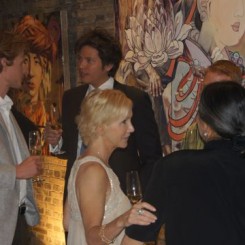I had an instance in 2005. We had the winner of the Dragonair Emerging Chinese Artist Award, a painter. She was a year out of art school in Hangzhou, and for a solo show she got USD 10,000 from Dragonair. We made a catalogue and sold almost all of her works. There were absolutely no problems, and she is actually very well-known now. She signed across the street with another gallery who pushed her up, and we kept her price at what we thought a first-year student would get, despite the fact that she was the winner. We had her at four, five or six [thousand] USD. They put her at USD 23,000, and then put her immediately in an auction. This girl, for the last three years, has gone nowhere; she’s lost. She’s totally lost, because she stopped selling at that particular price. Her work isn’t that brilliant and it was quite limited in its scope; she was unfortunately representing that period of 2000—2008 of “I want to be an artist. It’s cool to be an artist. I’m going to make money. I want to be number one and I’m going to take what I can get right now.” I saw recently that her work was put up for auction again, but now her prices are back to where they began.
CM: So rather than saying that the market recovered from 2008, you’d say it matured?
EdeB: I think 2008 was the best thing that could have happened. I think it made a huge division, sort of a massive attrition of those who pretend to be artists, the wannabes, and those who are really original artists. The fake prices, either by very well-known artists or not-so-well-known artists, were stopped [by the crash]. It really did give the market a wake-up call. Since then it has matured in a healthier way.
Notwithstanding that, there are exceptions, such as Ai Weiwei and his situation. He has never known so much European and American recognition, and you do ask the question, are his media outbursts and his radical beliefs making his art, or is it art making his media? So you really have certain exceptions that are going to continue in the way they have been for many years. But on the whole, I think it’s healthier.
CM: Art funds of course also took a major hit in 2008, not only in China but all around the world, but in China they appeared to have recovered very strongly, in popularity if not necessarily in performance (which is very hard to measure objectively). What is your perspective on the art fund — is it a general term of description that covers up the fact that there are a variety of different concepts applied here, or what’s going on?
EdeB: I absolutely agree with you that art funds have become sort of the new trend. Whereas before, it was sort of “I have my own building and now I have my own museum,” it’s been replaced with “I have an art fund or a corporation doing art funds.” It is the new flavor.
How do I feel about it? I am involved with a few of them, but they are individuals that truly adore art and have been doing art funds for many, many years overseas. So my take on it is that it is a slightly more mature dialogue, but the same way generally.
CM: So what, in your opinion, are the major problems with the art market in China? What does it still need? What needs to change?
EdeB: What would be amazing, if I had a magic wand, would be to create an exchange between international art professors coming to the Mainland fine arts universities and departments. I would not only have the old boys’ system, which will always exist because it is part of the Chinese culture, but freshen it up, open it up a little bit. So I think you start with the students, giving them more of an opportunity to have an exposure [to international art dialogue] without having to travel to new places. Start there.
And it would be lovely to have some very new, government-run and government-funded art programs. I’d love to see [more] programming in museums and not just have these private museums that are more or less “night galleries,” ways in which someone can show his art collection with a view to selling it at a later date.
I would love to see more of a cultural aspect from the government working with non-profit charities; I’m looking at ten years ahead where there is no division between public and private.
I would like to see more video (I think video is still young and undeveloped) and installation. That is a little bit more evolved, because I have been looking at the same installation dialogue as for the last ten years.
And there are tremendous artisans in the Chinese market. It would be amazing to see contemporary porcelain. The Koreans are doing very interesting porcelain in contemporary art. It would be nice to be able to go back into woodwork craftsmanship. Chinese contemporary art is getting back into Chinese ink. I think it will happen in time, but it would be nice to see more usage of their ancestry and different crafts.
CM: Do you have one or two predictions for the next twelve months?
EdeB: Predictions: I am actually looking into more pan-Asian art. I think that Vietnamese, Thai, and Indian art — and from Arab nations too — actually have developed very, very well. I am trying slowly to interest collectors and funds into more pan-Asian dialogue, and that’s my prediction – more diversity and more cultural diversity.
